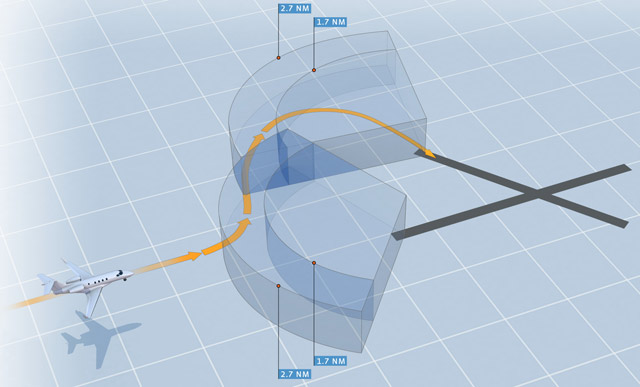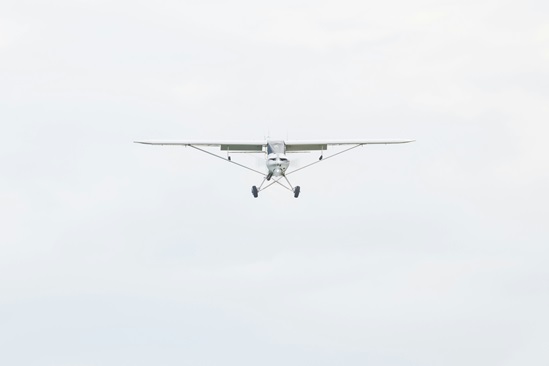
The protected areas for circle-to-land maneuvers are slowly being expanded. Airplanes in Category B are protected out to a 2.7-nm radius, up from 1.7 nm. Look for an encircled “C” (NACO charts) or a diamond symbol (Jeppesen) on approach plates to see if expanded circling applies.
Illustration by Charles Floyd
Bumping up circling radii
Circling approaches have long been recognized as one of the more hazardous maneuvers a jet pilot might execute. By definition, most are visual procedures conducted in IMC—the only situation in which such a paradoxical operation is asked of a pilot. Over the years, many operators have opted to simply not conduct circling approaches unless the conditions are legally VMC. What’s more, many pilots carry type ratings explicitly limiting the pilot to circle only in VMC.
If circling approaches weren’t difficult enough, for decades the FAA had created the procedures in such a manner as to be more difficult to execute than they would be elsewhere in the world. The “procedures for air navigation services-aircraft operations” (PANS-OPS) document used to create instrument procedures in most of the world outside the United States and Canada have traditionally provided for more realistic VA and protected areas in which to execute a circling procedure than are afforded by the terminal instrument procedures (TERPS) guidance used domestically. Thankfully, after years of consideration, the FAA recently has aligned circling procedure construction to match more closely the widely used PANS-OPS standard.
Consider a Phenom 100 flying the LOC DME approach into Aspen, Colorado (ASE). While the Phenom is a Category B aircraft based on its maximum reference approach speed of 106 knots—well below the cutoff of 120 knots—it is required to maneuver at 130 knots during circling procedures. Thus, under TERPS, it must utilize the higher Category C approach minimums.
Here is the first difference between TERPS and PANS-OPS: PANS-OPS recognizes aircraft will maneuver faster during a circling procedure and allows for this without requiring the pilot to bump up a category. For Category B aircraft, circling up to 135 KIAS is allowed, so the Phenom pilot wouldn’t need to look at a different category for circling versus straight-in procedures.
At the circling MDA of 10,220 feet, an indicated airspeed of 130 knots yields a true airspeed (TAS) of 156 knots. With such a high TAS the turn diameter in a 25-degree bank increases from a sea level value of 1.1 nm to 1.5 nm. Contrast this with the 1.7-nm protected radius around the airport provided by procedures designed with pre-2013 TERPS guidance.
The pilot has only two-tenths of a nautical mile (or a little more than 1,200 feet) margin of error in planning the flight track to both stay within the protected airspace and maneuver from downwind to final without overshooting the extended centerline. Add in adverse winds and the maneuver becomes impossible.
Further, the calculations don’t take into account any attempt to fly a stabilized approach. To descend on a standard 300-feet-per-nautical-mile path from the MDA of 2,383 feet above the airport, the pilot would need a linear path more than seven nm long. Even if the pilot began descent on downwind well before the landing end of the runway, a turn diameter between three and four nm would be needed to fly a normal descent throughout the maneuver.
PANS-OPS has long provided for more realistic maneuvering areas; in the case of the Phenom maneuvering at 130 KIAS (still falling under Category B), a protected area of just under 2.7 nm is given, 60 percent more than under “old” TERPS.
Fortunately, in 2013 the FAA began charting procedures under revised TERPS guidance much more closely aligned with PANS-OPS. Under the new TERPS, the protected area for Category B, C, and D aircraft is increased, often significantly. Additionally, for the first time the protected radius increases as the MDA (in msl) of the approach goes up. This now allows for equivalent maneuvering protection with increasing TAS as altitude is increased.
For the Phenom (and most other single-pilot light jets) maneuvering under TERPS as a Category C aircraft, the minimum protected area radius increases to 2.7 nm, nicely aligned with PANS-OPS. Even better, at Aspen’s 10,220-foot MDA the approach would now be designed with a 3.3-nm protected radius, nearly double the 1.7 nm afforded under the old TERPS. Pilots can tell what procedures allow for an expanded circling area by the presence of a “C” in a box (NACO chart), or diamond (Jeppesen chart). Eventually all procedures will be aligned with the new TERPS guidance, although this will take several years.
Neil Singer is a Master CFI with more than 8,500 hours in 15 years of flying.


